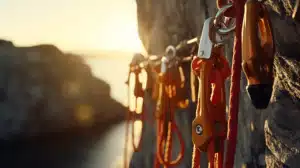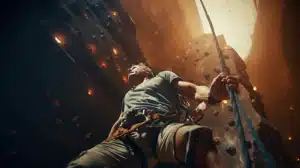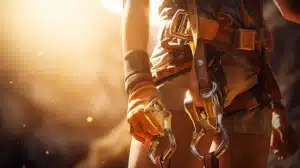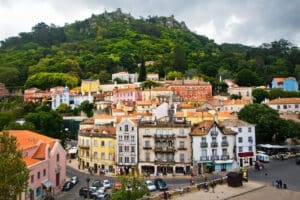Trad climbing is where I come from, and even though I am probably climbing in this style less than ever before, it is still where my heart lies and so I look forward to any trip back home with great anticipation.
After our action packed trip to Reunion Island, and a hectic schedule of presentations and trade shows in the few weeks that followed, we were feeling a little tired and out of shape, not exactly a great state for trying hard projects in Pembrokeshire. Not to worry, we were passing by Innsbruck, probably the best place for indoor scenes in Europe and so embarked on a crash course of Tivoli endurance training to knock us back into shape. The training worked as planned and we left the gym in a much better state than we had arrived, but I also left with something a little less desirable – a sharp pain in my left ring finger!
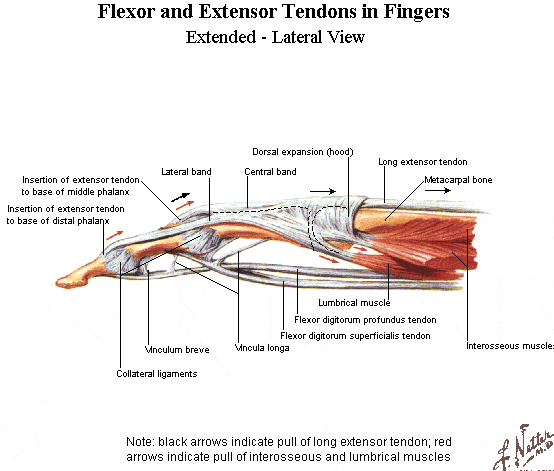
hmmmmmmm, what could it be?
I should have known better than to train when exhausted, but with the power of hindsight that is easy to say. Whatever… what is done is done, and I arrived in the UK barely able to pull on jugs without serious pain. I was sad to say the least, as one of my main projects for the year had ended before it had even begun, but Caro managed to get me to see the bright side of things, confirming that if you look hard enough you can usually find a silver lining. Taking some time off from my own climbing allowed me to focus on the development of Caroline. We tackled loads of classic routes, focusing less on the difficulty and more on gear placement, rope management, and general tactics for approaching Trad, and in the space of one week, she had come on leaps and bounds.
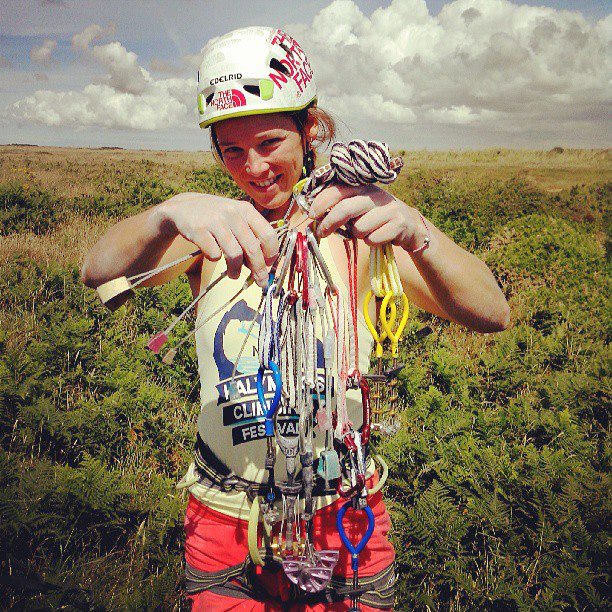
Learning and remembering the gear…
(Actually, the more I thought about it, the more I understood there were a lot of things to say on the subject that people out there might find interesting/useful, so, we also shot a small instructional video with Wild Country which should be online soon)
Most days Trad climbing are spent on-sighting, which although mentally exhausting, rarely manages to get you tired. It’s an odd feeling at the end of the day, like you have come back from a long day in the mountains, but knowing you can count the number of pitches you made on one hand! For a start the routes are often slabby, involving a lot of standing on your feet, and in addition you spent the majority of your time searching out and fiddling in gear, rarely actually getting stuck into a hard section of climbing for more than a few meters. Its the nature of trad, to take things slowly, cautiously, and it is certainly the most sensible way to approach this potentially dangerous style. If your climbing at your max, slapping wildly for the next holds, fingers uncurling and elbows by your ears, you have probably pushed things too far.
There are however rare occasions where you can get this fix, steep routes, with just the right amount of good gear, where you can climb hard long sections between the protection, with nothing worse than a (very scary) long fall awaiting you should you fall. Pembroke is probably the best place in the UK for routes of this style, and it is why it has become my favourite place to go climbing on our fair isle. Routes like Hindenburg, From Dusk until Dawn, Point Blank, San Simeon, and Chupacabra are all excellent examples of this, and should be on any aspiring sport/trad climbers “conversion” list.
Having already ticked a few of the easier examples Caro felt it was time to get stuck into something a little harder, and decided to take a look at Chupacabra. Originally considdered E9, Chupacapra would be the hardest trad route Caroline had ever tried, and after failing to even climb some of the moves during her first practice session, its reputation seemed well deserved. It took a lot of time (ok, only 4 days but this is far more than usual routes for Caro) and a lot of soul searching, but eventually Caro was able to make the 5th ascent (1st female) of this exceptional route.
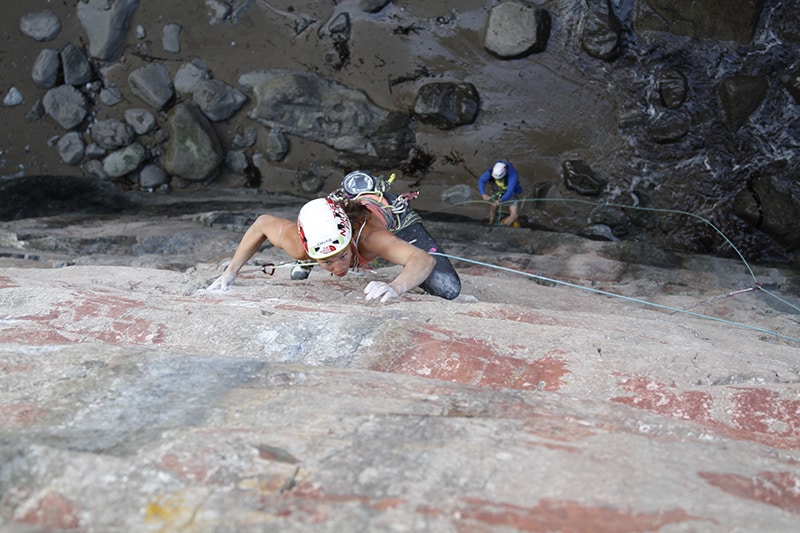
Caro on the lead of Chupacabra, possibly the hardest female ascent in Pembroke? Photo Adrian Samarra
Clearly on good form, and pushed on by my restless enthusiasm after barely climbing for a week, we made the slow drive North to Treardurr bay, the home of Chicama, a confirmed E9 from Tim Emmet from over 10 years ago, and in theory, a step up from Chupacabra. The route has recently come back onto the radar, and seen a few ascents, partly thanks to the addition and replacement of several pegs, making it a little less scary than it had perhaps originally been. I’m not an expert on the ethics of fixed gear and sea cliff climbing, so couldn’t tell you if this is regarded as poor form, but it seems an odd concept considering the difficulty of the route is partly based on how dangerous it is (was) – I personally see pegs as one of the worst (most dangerous) aspects of “trad” climbing, and would prefer to see them removed all together, but this is a discussion for another time.
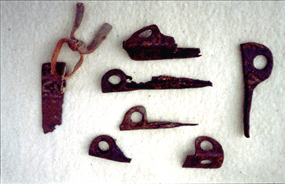
Examples of corroded pegs taken out of routes…
Either way, the route is what it is – an incredibly steep sea cliff and (for the UK) very impressive climbing territory. I abseiled down the route clipping into the aforementioned pegs, fixing a short static line as I went. Caroline rappelled just above me, clipping into the fixed line and trying the moves. I jumared back out, belayed Caro up, and waited for low tide. Once the time was right, we rappelled back down the route to the usually submerged boulder, cleaning all of the gear and slings to leave it as clean as possible, then Caroline lead the route on her first try, placing everything on lead.
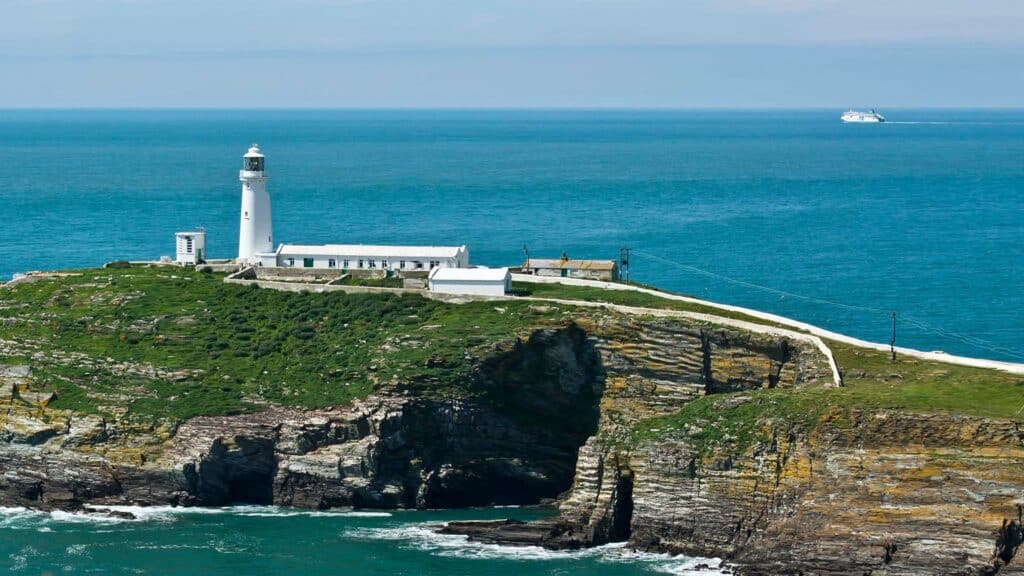
Treardurr Bay…
We got back in the Van and started to drive home.
The difference between the two experiences could not have been greater and is just another in a long line of reminders that grades are only a guideline. Clearly, the steep well protected jugs of Chicama suited Caroline more than the vertical, crimpy crux of Chupacabra. It is our own strengths and weakness that will define our experience. There is no universal truth, but many personal scales, and all we can be is honest about how things felt. For Caroline, Chicama felt similar to Point Blank (Better protected but harder) and My Piano (Easier but much bolder). It was easier than The Jackals (Similar difficulty but bolder, 2 days of work), and much easier than Chupacabra (harder and more scary, 4 days of work).


